Adaptation after Extreme Flooding Events: Moving or Staying? The Case of the Ahr Valley in Germany
Abstract
1. Introduction
2. Flood Impacts in the Ahr Valley and Perspective on Reconstruction and Relocation
- How do affected people in the Ahr Valley assess relocation as well as settlement retreat?
- What types of relocation and migration can be observed (e.g., temporarily or permanently)?
- Who relocated permanently from the area and who did so only temporarily or not at all?
- What motivates affected people to stay or to leave the original location?
- Which factors are decisive for people moving out when choosing a new location?
- How do people evaluate the need for relocating critical and sensitive infrastructures?
3. Materials and Methods
3.1. Case Study Area
3.2. Collection and Description of the Household Survey Sample
3.3. Analysis Framework
4. Results
4.1. Housing Situation and Relocation Behavior of Different Groups
4.2. Reasons for Relocation and the Selection of a New Location
4.3. Reasons for Staying
4.4. Settlement Retreat
5. Discussion
6. Conclusions
Supplementary Materials
Author Contributions
Funding
Institutional Review Board Statement
Informed Consent Statement
Data Availability Statement
Acknowledgments
Conflicts of Interest
Appendix A
| Variable | Definition | n | Summary Statistics Mean (Standard Dev.) or Percentages |
|---|---|---|---|
| Leaving home | Answer to the question of whether they had to leave their home because of a call, an official order, or because of the damage: yes = 1, no = 2. | 507 | 1 = 41.6% 2 = 57.4% |
| Duration of leaving home | Answer to the question “After how many days or months were you able to return to your home permanently?”: after 1-2 days (1); after about a week (2); after about two weeks (3); after about one month (end of August 2021) (4); after about two months (end of September 2021) (5); after about four months (end of November 2021) (6); after about six months (end of January 2022) (7); after about eight months (end of March 2022) (8); not until today (9) | 216 | 1 = 6.0% 2 = 1.9% 3 = 2.3% 4 = 9.7% 5 = 11.1% 6 = 11.6% 7 = 7.9% 8 = 13.4% 9 = 36.1% |
| Current housing situation | Information on current housing situation (i.e., at the time of the survey) with several choices: in the same house/apartment as in July 2021 (1), in temporary housing/with friends/relatives (2), permanently in another house/apartment in the same district (3), permanently in another district (4), permanently in another city (5). | 512 | 1 = 73.0% 2 = 12.9% 3 = 4.1% 4 = 2.1% 5 = 7.8% |
| Current housing situation (excluding those who have already moved permanently) | Information on current housing situation (i.e., at the time of the survey) with several choices: in the same house/apartment as in July 2021 (1), in temporary housing/ with friends/relatives (2) | 440 | 1 = 85.0% 2 = 15.0% |
| Location of the new residence | Location of the new building (if already moved permanently): inside legally defined floodplain valid in July 2021 (1); outside legally designated floodplain valid in July 2021, but within the July 2021 flood zone (2); outside legally designated floodplain and outside the July 2021 flood zone (3) | 53 | 1 = 11.3% 2 = 20.7% 3 = 67.9% |
| Future intended housing situation | Stay on site in the same house/apartment (1), move already carried out or planned (2) | 490 | 1 = 79.2% 2 = 20.8% |
| Move planned | Answer to the question if they plan to move: yes = 1, no = 2. | 422 | 1 = 7.1% 2 = 92.9% |
| Ownership structure (in July 2021) | Answer to the question whether they were living for rent or in their own property/ property of close relatives in July 2021: rent = 1, property/ property of close relatives = 2 | 515 | 1 = 32.4% 2 = 67.6% |
| Damage | Amount of financial damage to personal belongings and building/property: under 500 € (1), 500–999 € (2), 1000–4999 € (3), 5000–9999 € (4), 10,000–24,999 € (5), 25,000–49,999 € (6), 50,000–74,999 € (7), 75,000–99,999 € (8) and 100,000 € or more (9) | 492 | 1 = 0.2% 2 = 0.2% 3 = 5.7% 4 = 6.3% 5 = 12.0% 6 = 10.2% 7 = 8.9% 8 = 4.7% 9 = 52.8% |
| Current condition of the personal belongings and building/property | Comparison of current condition of personal belongings and building/property with pre-flood condition on a six-point Likert scale from 1 = completely replaced to 6 = significant deficiencies | 489 | 3.87 (1.67) |
| Duration of residence in house/apartment | Duration of residence in house/apartment of July 2021: in the house/apartment for 0 to 1.5 years (i.e., moved in in 2020 or 2021) (1), for 1.5 to 5.5 years (2), for 5.5 to 10.5 years (3), for 10.5 to 25.5 years (4), and more than 25.5 years (5) | 503 | 1 = 7.6% 2 = 18.3% 3 = 14.1% 4 = 32.2% 5 = 27.8% |
| Pre-flood risk awareness | Answer to the question of whether they knew they lived in a flood-prone area before the 2021 flood event: yes (1), no (2). | 496 | 1 = 17.7% 2 = 83.3% |
| Location of original residence | Location of the July 2021 residence: inside legally defined floodplain valid in July 2021 (1) or outside legally defined floodplain valid in July 2021 (2). Note: A choice of five options was offered to the respondents in the questionnaire: inside the special hazard “yellow” zone; inside the legally defined floodplain of July 2021; outside the legally defined floodplain of July 2021 but inside the new floodplain provisionally defined by law; outside new floodplain provisionally defined by law but inside the flooded area from July 2021; outside new floodplain provisionally defined by law and outside flooded area from July 2021. However, since such a detailed classification was rather inconvenient for the evaluation, the categories were combined into two main categories. | 401 | 1 = 25.7% 2 = 74.3% |
| Reasons for relocation | Answer to the question: “What are the reasons for your relocation?” (multiple answers were possible): I was living in a rented flat/house. (1); My place of residence no longer offers a quality of life. (2); The location is too dangerous for me. (3); Reconstruction/refurbishment is too expensive and/or too complex for me. (4) | 124 | 1 = 43.5% 2 = 40.3% 3 = 27.4% 4 = 10.5% |
| Importance of factors when deciding on a new location | Assessment of importance of different factors when deciding on a new location on a six-point Likert scale (from 1 = completely unimportant to 6 = very important): good social environment (1); flood-proof location of the new building (2); good connection to local supply (3); sustainability and energy efficiency of the new building (4); financial support from the state (5); good connection to public transport (6); flood-adapted construction of the new building (7); short distance to former place of residence (8); remaining in the same (associated) municipality (9); joint move with other affected neighbors (10). | 1–106 2–104 3–109 4–104 5–100 6–107 7–92 8–106 9–107 10–97 | 1 = 5.11 (1.12) 2 = 5.09 (1.41) 3 = 4.99 (1.29) 4 = 4.88 (1.37) 5 = 4.49 (1.74) 6 = 4.23 (1.69) 7 = 4.18 (1.56) 8 = 3.77 (1.82) 9 = 3.67 (2.07) 10 = 2.03 (1.50) |
| Importance of safety | Agreement with the thesis “I am someone to whom it is important to live in a safe environment and who avoids anything that threatens my own safety.” on a six-point Likert scale from 1 = not true at all to 6 = absolutely true. | 504 | 4.30 (1.36) |
| Probability of a recurrence of flooding | Assessment of probability on a six-point Likert scale from 1 = very unlikely to 6 = very likely with regard to the following question: “How likely do you think it is that your current apartment/house will be affected by flooding again?” | 487 | 3.34 (1.56) |
| Severity of a recurrence of flooding | Assessment of severity on a six-point Likert scale from 1 = not bad to 6 = very bad with regard to the following question: “How do you assess the impact of a possible future flood on yourself personally?” | 493 | 4.91 (1.39) |
| Reasons for staying | Answer to the question: “What are key factors that influenced your decision to stay in the same location?” (multiple answers were possible): I feel strongly rooted in the place I live. (1); I don’t think a move is necessary because an extreme flood is very rare. (2); I don’t think a move is necessary because my building can be protected from floods. (3); I don’t have the strength/energy to move. (4); I don’t have the finances to move/I cannot adequately use the reconstruction funds to move to another area. (5); I wasn’t able to deal with the issue of “settlement retreat/relocation” during reconstruction. (6); I can’t find any suitable replacement areas nearby. (7); I can’t sell my building because the market value has dropped too much. (8); I don’t think a move is necessary because my residential building was not affected by the 2021 flood. (9) | 414 | 1 = 56.0% 2 = 50.5% 3 = 14.7% 4 = 19.6% 5 = 17.1% 6 = 4.6% 7 = 14.7% 8 = 13.5% 9 = 2.4% |
| Feeling informed about the designation of the floodplains and the settlement retreat | Agreement with the statement “I feel well informed regarding the settlement retreat and floodplain designation.” on a six-point Likert scale from 1 = disagree at all to 6 = agree completely. | 465 | 2.22 (1.34) |
| Assessment of a settlement retreat | Agreement with the statement “I consider a settlement retreat to be a meaningful measure in terms of risk prevention and climate change adaptation.” on a six-point Likert scale from 1 = disagree at all to 6 = agree completely. | 479 | 4.28 (1.64) |
| Assessment of a relocation of critical and sensitive infrastructures | Agreement with the statement “Particularly sensitive or critical infrastructures (e.g., hospitals, schools) should be relocated from the immediate vicinity of the Ahr River.” on a six-point Likert scale from 1 = disagree at all to 6 = agree completely. | 486 | 4.78 (1.38) |
| Gender | Female = 1, male = 2, divers = 3 | 510 | 1 = 47.6% 2 = 52.4% 3 = 0.0% |
| Age | Age groups from 20–29 years (1), from 30–49 years (2), from 50–64 years (3), from 65–79 years (4), and over 80 years (5) | 512 | 1 = 4.3% 2 = 20.9% 3 = 41.8% 4 = 25.0% 5 = 8.0% |
| Household income | Monthly net household income (after deduction of taxes and social contributions, but including all income, i.e., also income from rent, pension, etc.): below 900 € (1), 900–1299 € (2), 1300–1499 € (3), 1500–1999 € (4), 2000–2599 € (5), 2600–3599 € (6), 3600–4999 € (7) and 5000 € or more (8). | 443 | 1 = 1.1% 2 = 5.4% 3 = 4.1% 4 = 11.5% 5 = 18.5% 6 = 24.2% 7 = 16.9% 8 = 18.3% |
| Variables | n | Spearman’s ρ | p |
|---|---|---|---|
| Current housing situation (excluding those who have already moved permanently) & Move planned | 490 | −0.116 | 0.018 |
| Ownership structure (in July 2021) & Future intended housing situation | 489 | −0.323 | <0.001 |
| Gender & Future intended housing situation | 487 | 0.034 | 0.452 |
| Age & Future intended housing situation | 488 | −0.071 | 0.117 |
| Household income & Future intended housing situation | 423 | −0.067 | 0.167 |
| Current housing situation (excluding those who have already moved permanently) & Household income | 376 | 0.051 | 0.323 |
| Damage & Future intended housing situation | 468 | −0.063 | 0.173 |
| Current condition of the personal belongings and building/property & Household income | 443 | −0.154 | 0.002 |
| Current condition of the personal belongings and building/property & Future intended housing situation | 465 | 0.118 | 0.011 |
| Current condition of the personal belongings and building/property & Current housing situation (excluding those who have already moved permanently) | 418 | 0.293 | <0.001 |
| Ownership structure (in July 2021) & Current housing situation (excluding those who have already moved permanently) | 439 | 0.092 | 0.054 |
| Duration of residence in house/apartment & Future intended housing situation | 479 | −0.139 | 0.002 |
| Location of original residence & Pre-flood risk awareness | 391 | 0.214 | <0.001 |
| Pre-flood risk awareness & Future intended housing situation | 471 | −0.040 | 0.391 |
| Location of original residence & Future intended housing situation | 383 | −0.143 | 0.005 |
| Location of original residence & Ownership structure (in July 2021) | 400 | 0.313 | <0.001 |
| Age & I was living in a rented flat/house (reasons for relocation). | 122 | −0.215 | 0.018 |
| Age & The location is too dangerous for me (reasons for relocation). | 122 | 0.141 | 0.121 |
| Age & My place of residence no longer offers a quality of life (reasons for relocation). | 122 | 0.035 | 0.701 |
| Gender & I was living in a rented flat/house (reasons for relocation). | 121 | −0.034 | 0.714 |
| Gender & The location is too dangerous for me (reasons for relocation). | 121 | −0.139 | 0.129 |
| Gender & My place of residence no longer offers a quality of life (reasons for relocation). | 121 | 0.177 | 0.053 |
| Gender & Reconstruction/refurbishment is too expensive/too complex for me (reasons for relocation). | 121 | −0.053 | 0.566 |
| Household income & I was living in a rented flat/house (reasons for relocation). | 105 | −0.140 | 0.154 |
| Household income & The location is too dangerous for me (reasons for relocation). | 105 | 0.169 | 0.085 |
| Household income & My place of residence no longer offers a quality of life (reasons for relocation). | 105 | 0.046 | 0.644 |
| Household income & Reconstruction/refurbishment is too expensive/too complex for me (reasons for relocation). | 105 | −0.049 | 0.622 |
| Gender & Importance of safety | 500 | −0.047 | 0.292 |
| Gender & Probability of a recurrence of flooding | 482 | −0.136 | 0.003 |
| Gender & Severity of a recurrence of a flooding | 488 | −0.173 | <0.001 |
| Age & Reasons for staying: Rootedness (1). | 410 | −0.112 | 0.023 |
| Age & Reasons for staying: Rarity of an extreme flood (2). | 410 | 0.010 | 0.839 |
| Age & Reasons for staying: Building can be protected (3). | 410 | 0.021 | 0.670 |
| Age & Reasons for staying: No strength/energy (4). | 410 | 0.157 | 0.001 |
| Age & Reasons for staying: No finances (5). | 410 | 0.025 | 0.620 |
| Age & Reasons for staying: Not able to deal with the issue (6). | 410 | 0.103 | 0.038 |
| Age & Reasons for staying: No suitable replacement areas (7). | 410 | −0.136 | 0.006 |
| Age & Reasons for staying: Not able to sell due to too much decreased market price (8). | 410 | 0.030 | 0.539 |
| Age & Reasons for staying: Building was not affected (9). | 410 | 0.003 | 0.946 |
| Gender & Reasons for staying: Rootedness (1). | 408 | −0.073 | 0.139 |
| Gender & Reasons for staying: Rarity of an extreme flood (2). | 408 | 0.210 | <0.001 |
| Gender & Reasons for staying: Building can be protected (3). | 408 | 0.118 | 0.017 |
| Gender & Reasons for staying: No strength/energy (4). | 408 | −0.015 | 0.770 |
| Gender & Reasons for staying: No finances (5). | 408 | 0.086 | 0.082 |
| Gender & Reasons for staying: Not able to deal with the issue (6). | 408 | 0.041 | 0.404 |
| Gender & Reasons for staying: No suitable replacement areas (7). | 408 | −0.019 | 0.701 |
| Gender & Reasons for staying: Not able to sell due to too much decreased market price (8). | 408 | −0.055 | 0.269 |
| Gender & Reasons for staying: Building was not affected (9). | 408 | −0.036 | 0.464 |
| Household income & Reasons for staying: Rootedness (1). | 355 | −0.003 | 0.957 |
| Household income & Reasons for staying: Rarity of an extreme flood (2). | 355 | 0.090 | 0.091 |
| Household income & Reasons for staying: Building can be protected (3). | 355 | 0.093 | 0.081 |
| Household income & Reasons for staying: No strength/energy (4). | 355 | −0.093 | 0.081 |
| Household income & Reasons for staying: No finances (5). | 355 | −0.091 | 0.086 |
| Household income & Reasons for staying: Not able to deal with the issue (6). | 355 | 0.021 | 0.692 |
| Household income & Reasons for staying: No suitable replacement areas (7). | 355 | 0.080 | 0.132 |
| Household income & Reasons for staying: Not able to sell due to too much decreased market price (8). | 355 | 0.038 | 0.472 |
| Household income & Reasons for staying: Building was not affected (9). | 355 | 0.035 | 0.510 |
| Ownership structure (in July 2021) & Assessment of a settlement retreat | 478 | −0.075 | 0.100 |
| Probability of a recurrence of flooding & Assessment of a settlement retreat | 456 | 0.176 | <0.001 |
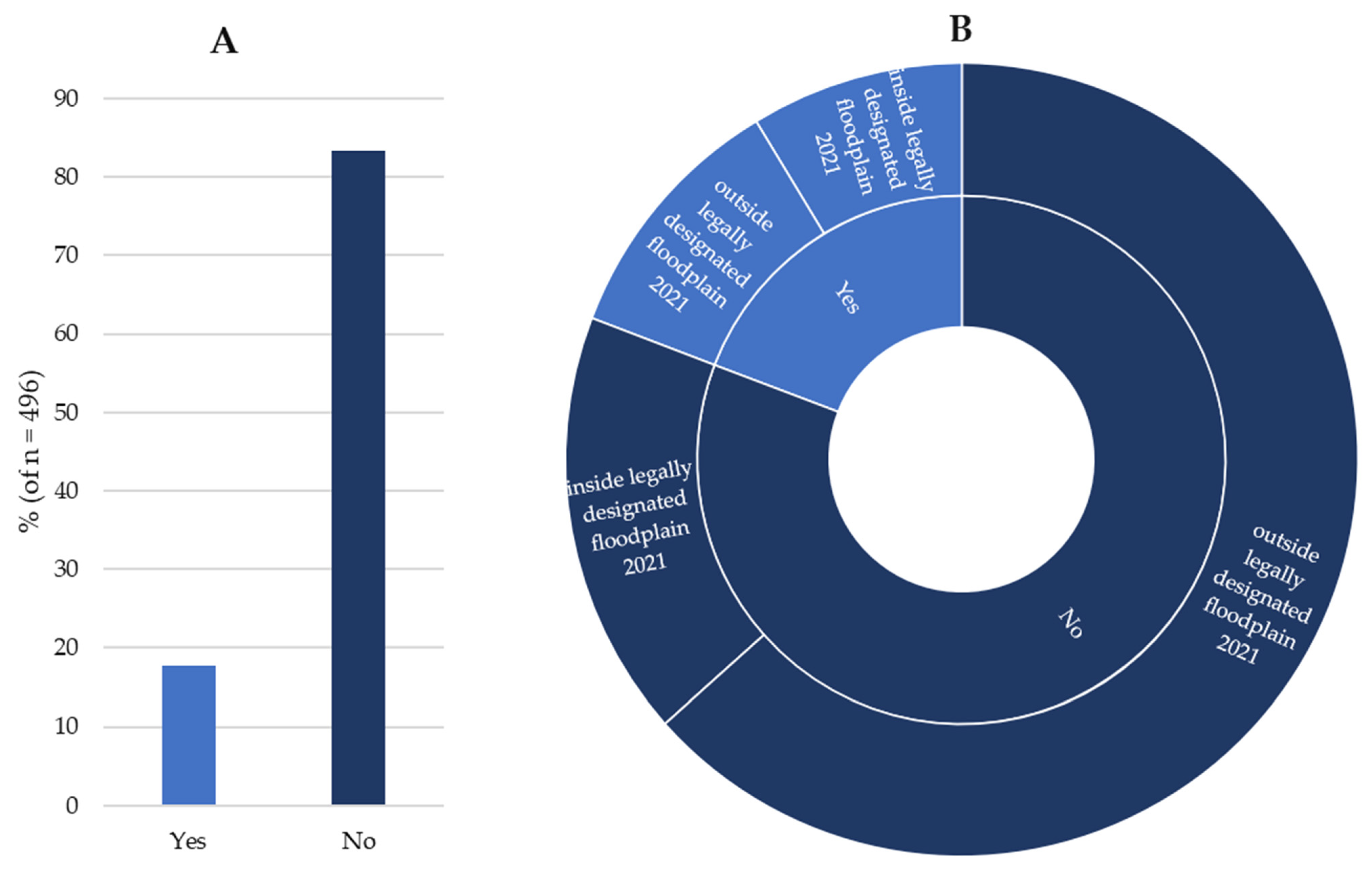
References
- Leighton, M.; Shen, X.; Warner, K. (Eds.) Climate Change and Migration: Rethinking Policies for Adaptation and Disaster Risk Reduction; Outcomes of the Fifth UNU-EHS Summer Academy of the Munich Re Foundation Chair on Social Vulnerability, 25–31 July 2010, Hohenkammer, Germany; UNU-EHS: Bonn, Germany, 2011; ISBN 978-3-939923-50-3. [Google Scholar]
- Ferris, E.; Weerasinghe, S. Promoting Human Security: Planned Relocation as a Protection Tool in a Time of Climate Change. J. Migr. Hum. Secur. 2020, 8, 134–149. [Google Scholar] [CrossRef]
- IPCC. Summary for Policymakers. In Climate Change 2022: Impacts, Adaptation and Vulnerability. Contribution of Working Group II to the Sixth Assessment Report of the Intergovernmental Panel on Climate Change; Pörtner, H.-O., Roberts, D.C., Tignor, M., Poloczanska, E.S., Mintenbeck, K., Alegría, A., Craig, M., Langsdorf, S., Löschke, S., Möller, V., et al., Eds.; Cambridge University Press: Cambridge, UK; Cambridge University Press: New York, NY, USA, 2022; pp. 3–33. [Google Scholar]
- United Nations Office for Disaster Risk Reduction. Sendai Framework for Disaster Risk Reduction 2015–2030. In Proceedings of the Third UN World Conference on Disaster Risk Reduction, Sendai, Japan, 14–18 March 2015; Available online: https://www.preventionweb.net/files/43291_sendaiframeworkfordrren.pdf (accessed on 3 January 2023).
- Die Bundesregierung. Deutsche Anpassungsstrategie an den Klimawandel: Vom Bundeskabinett am 17. Dezember 2008 beschlossen. 2008. Available online: https://www.bmuv.de/fileadmin/bmu-import/files/pdfs/allgemein/application/pdf/das_gesamt_bf.pdf (accessed on 3 January 2023).
- Umweltbundesamt. Monitoringbericht 2019 zur Deutschen Anpassungsstrategie an den Klimawandel: Bericht der Interministeriellen Arbeitsgruppe Anpassungsstrategie der Bundesregierung, Dessau-Roßlau, 2019. Available online: https://www.umweltbundesamt.de/publikationen/monitoringbericht-2019 (accessed on 3 January 2023).
- Jamshed, A.; Rana, I.A.; McMillan, J.M.; Birkmann, J. Building community resilience in post-disaster resettlement in Pakistan. Int. J. Disaster Resil. Built Environ. 2019, 10, 301–315. [Google Scholar] [CrossRef]
- Nalau, J.; Handmer, J. Improving Development Outcomes and Reducing Disaster Risk through Planned Community Relocation. Sustainability 2018, 10, 3545. [Google Scholar] [CrossRef]
- IDMC. Global Report on Internal Displacement 2021: Internal Displacement in a Changing Climate; Lennard, J., Ed.; Internal Displacement Monitoring Centre: Geneva, Switzerland, 2021. [Google Scholar]
- Kam, P.M.; Aznar-Siguan, G.; Schewe, J.; Milano, L.; Ginnetti, J.; Willner, S.; McCaughey, J.W.; Bresch, D.N. Global warming and population change both heighten future risk of human displacement due to river floods. Environ. Res. Lett. 2021, 16, 44026. [Google Scholar] [CrossRef]
- IPCC. Summary for Policymakers. In Climate Change 2021: The Physical Science Basis. Contribution of Working Group I to the Sixth Assessment Report of the Intergovernmental Panel on Climate Change; Masson-Delmotte, V., Zhai, P., Pirani, A., Connors, S.L., Péan, C., Berger, S., Caud, N., Chen, Y., Goldfarb, L., Gomis, M.I., et al., Eds.; Cambridge Press: Cambridge, UK; Cambridge Press: New York, NY, USA, 2021; pp. 3–32. [Google Scholar]
- Alfieri, L.; Dottori, F.; Betts, R.; Salamon, P.; Feyen, L. Multi-Model Projections of River Flood Risk in Europe under Global Warming. Climate 2018, 6, 6. [Google Scholar] [CrossRef]
- Deumlich, D.; Gericke, A. Frequency Trend Analysis of Heavy Rainfall Days for Germany. Water 2020, 12, 1950. [Google Scholar] [CrossRef]
- Kreienkamp, F.; Philip, S.Y.; Tradowsky, J.S.; Kew, S.F.; Lorenz, P.; Arrighi, J.; Belleflamme, A.; Bettmann, T.; Caluwaerts, S.; Chan, S.C.; et al. Rapid Attribution of Heavy Rainfall Events Leading to the Severe Flooding in Western Europe during July 2021. 2021. Available online: https://www.worldweatherattribution.org/wp-content/uploads/Scientific-report-Western-Europe-floods-2021-attribution.pdf (accessed on 5 January 2023).
- Birkmann, J.; Tetzlaff, G.; Zentel, K.O. Addressing the Challenge: Recommendations and Quality Criteria for Linking Disaster Risk Reduction and Adaptation to Climate Change; DKKV Publication Series No. 38; German Committee for Disaster Reduction: Bonn, Germany, 2009; Available online: https://www.preventionweb.net/files/10193_DKKVreport.pdf (accessed on 22 December 2022).
- Arnall, A. A climate of control: Flooding, displacement and planned resettlement in the Lower Zambezi River valley, Mozambique. Geogr. J. 2014, 180, 141–150. [Google Scholar] [CrossRef]
- Mucherera, B.; Spiegel, S. Forced displacement: Critical lessons in the protracted aftermath of a flood disaster. GeoJournal 2022, 87, 3855–3875. [Google Scholar] [CrossRef] [PubMed]
- Fernando, N. Forced Relocation after the Indian Ocean Tsunami 2004: Case study of Vulnerable Populations in Three Relocation Settlements in Galle, Sri Lanka, Neue Ausg; United Nations University Institute for Environment and Human Security: Bonn, Germany, 2012; ISBN 978-3-939923-72-5. [Google Scholar]
- UNHCR—The UN Refugee Agency. Planned Relocation, Disasters and Climate Change: Consolidating Good Practices and Preparing for the Future; UNHCR: Sanremo, Italy, 2014; Available online: https://www.unhcr.org/54082cc69.pdf (accessed on 7 December 2022).
- King, D.; Bird, D.; Haynes, K.; Boon, H.; Cottrell, A.; Millar, J.; Okada, T.; Box, P.; Keogh, D.; Thomas, M. Voluntary relocation as an adaptation strategy to extreme weather events. Int. J. Disaster Risk Reduct. 2014, 8, 83–90. [Google Scholar] [CrossRef]
- Seebauer, S.; Winkler, C. Should I stay or should I go? Factors in household decisions for or against relocation from a flood risk area. Glob. Environ. Change 2020, 60, 102018. [Google Scholar] [CrossRef]
- Die Landesregierung Rheinland-Pfalz. Ein Jahr Wiederaufbau in Rheinland-Pfalz nach der Naturkatastrophe vom 14./15. Juli 2021; Die Landesregierung Rheinland-Pfalz: Mainz, Germany, 2022; Available online: https://wiederaufbau.rlp.de/fileadmin/wiederaufbau/2022/07-Juli/Ein-Jahr-Wiederaufbau-in-RLP.pdf (accessed on 6 December 2022).
- Bundesministerium des Innern und für Heimat; Bundesministerium der Finanzen. Bericht zur Hochwasserkatastrophe 2021: Katastrophenhilfe, Wiederaufbau und Evaluierungsprozesse. Available online: https://www.bmi.bund.de/SharedDocs/downloads/DE/veroeffentlichungen/2022/abschlussbericht-hochwasserkatastrophe.pdf (accessed on 7 December 2022).
- Munich, R.E. Medieninformation: Wetterkatastrophen in USA dominieren Naturkatastrophen-Schadenstatistik 2021; Munich RE: München, Germany, 2022. [Google Scholar]
- Deutsches Komitee Katastrophenvorsorge, e.V. Opfer- und Schadensdaten zur Flut 2021 in Rheinland-Pfalz. DKKV Datenaufbereitung auf Basis der Daten der Aufsichts- und Dienstleistungsdirektion (ADD) Rheinland-Pfalz sowie vom Landesamt für Soziales, Jugend und Versorgung Rheinland-Pfalz (LSJV—RLP). Available online: https://www.dkkv.org/fileadmin/user_upload/Anfrage_Opfer-_und_Schadensdaten_der_Flut_2021.pdf (accessed on 7 December 2022).
- Büchs, W. 1.1 Historische Aspekte der Landschaftsentwicklung im Naturraum, Mittleres Ahrtal aus naturkundlicher Sicht, dargestellt am Beispiel des Naturschutzgebietes Ahrschleife bei Altenahr. In Beiträge Landespflege Rheinland-Pfalz 17; Die Landesregierung Rheinland-Pfalz: Oppenheim, Germany, 2003; pp. 7–196. [Google Scholar]
- Dietze, M.; Bell, R.; Ozturk, U.; Cook, K.L.; Andermann, C.; Beer, A.R.; Damm, B.; Lucia, A.; Fauer, F.S.; Nissen, K.M.; et al. More than heavy rain turning into fast-flowing water—A landscape perspective on the 2021 Eifel floods. Nat. Hazards Earth Syst. Sci. 2022, 22, 1845–1856. [Google Scholar] [CrossRef]
- Statistisches Landesamt Rheinland-Pfalz. Rheinland-Pfalz wird immer älter: Durchschnittsalter 2020 bei 45 Jahren. Available online: https://www.statistik.rlp.de/no_cache/de/einzelansicht/news/detail/News/3313/ (accessed on 7 December 2022).
- Statistisches Landesamt Rheinland-Pfalz. Mein Dorf, meine Stadt: Stadt Bad Neuenahr-Ahrweiler. Available online: https://infothek.statistik.rlp.de/MeineHeimat/content.aspx?id=103&l=3&g=0713100007&tp (accessed on 7 December 2022).
- dpa/ZDF. Fluten in Sinzig: Zwölf Tote in Heim für Beeinträchtigte. Available online: https://www.zdf.de/nachrichten/panorama/hochwasser-wohnheim-behinderung-tote-sinzig-100.html (accessed on 6 December 2022).
- Greiving, S.; Hurth, F.; Gollmann, C.; Kirstein, M.; Fleischhauer, M.; Hartz, A.; Saad, S. Siedlungsrückzug als planerische Strategie zur Reduzierung von Hochwasserrisiken. Raumforsch. Raumordn. 2018, 76, 193–209. [Google Scholar] [CrossRef]
- Mayr, B.; Thaler, T.; Hübl, J. Successful Small-Scale Household Relocation after a Millennial Flood Event in Simbach, Germany 2016. Water 2020, 12, 156. [Google Scholar] [CrossRef]
- Janssen, G.; Rubel, C.; Schulze, F.; Keimeyer, F. Siedlungsrückzug—Recht und Planung im Kontext von Klima- und demografischem Wandel; Climate Change 21/2016; Umweltbundesamt: Dessau-Roßlau, Germany, 2016. [Google Scholar]
- Seebauer, S.; Thaler, T.; Schindelegger, A.; Wenk, M.; Winkler, C. Gestaltung von Privater Absiedlung aus Hochwasser-Risikogebieten: Handbuch für Entscheidungsträgerinnen und -Träger; Forschungsbereich Bodenpolitik und Bodenmanagement: Wien, Austria, 2018. [Google Scholar]
- Seebauer, S.; Winkler, C.; Thaler, T. Soziale und Landnutzungs-Auswirkungen von Absiedlungen aus Hochwassergefährdeten Gebieten an den Fallbeispielen Eferdinger Becken und Machland: Laengsschnittstudie der Periode 2016–2018: Endbericht an den Klima-und Energiefonds; Endbericht an den Klima- und Energiefonds: Wien, Austria, 2019; Available online: https://relocate.joanneum.at/wp-content/uploads/2019/10/PublEndbericht-B567142.pdf (accessed on 7 December 2022).
- Statistisches Landesamt Rheinland-Pfalz. Mein Kreis, meine kreisfreie Stadt: Landkreis Ahrweiler. Available online: https://infothek.statistik.rlp.de/MeineHeimat/content.aspx?id=101&l=1&g=07131&tp (accessed on 7 December 2022).
- Kreisverwaltung Ahrweiler. Wirtschaftsförderung: Das Team stellt sich vor—Wir über uns! Available online: https://kreis-ahrweiler.de/wirtschaft/wirtschaftsfoerderung/die-kreiswirtschaftsfoerderung-stellt-sich-vor/ (accessed on 7 December 2022).
- Büchs, W. Das Naturschutzgebiet “Ahrschleife bei Altenahr” (einschließlich angrenzender schutzwürdiger Bereiche) Fauna, Flora, Geologie und Landespflegeaspekte.: Teil I. In Beiträge Landespflege Rheinland-Pfalz 16; Landesregierung Rheinland-Pfalz: Oppenheim, Germany, 1993; pp. 1–567. [Google Scholar]
- Ministerium für Klimaschutz, Umwelt, Energie und Mobilität Rheinland-Pfalz. Die Ahr. Available online: https://wasser.rlp-umwelt.de/servlet/is/1210/ (accessed on 7 December 2022).
- Statistisches Landesamt Rheinland-Pfalz. Statistische Berichte: Bestand und Struktur der Wohnungen: Wohnsituation der Haushalte 2006: Ergebnisse der Mikrozensus-Zusatzerhebung, Bad Ems. 2008. Available online: https://www.statistik.rlp.de/fileadmin/dokumente/berichte/A/1073/A1073_200601_4j_L.pdf (accessed on 6 December 2022).
- Weißer, B.V.; Jamshed, A.; Birkmann, J.; McMillan, J.M. Building Resilience After Climate-Related Extreme Events: Lessons Learned from Extreme Precipitation in Schwäbisch Gmünd. J. Extr. Even. 2020, 7, 2050010. [Google Scholar] [CrossRef]
- Fahrmeir, L.; Heumann, C.; Künstler, R.; Pigeot, I.; Tutz, G. Statistik: Der Weg zur Datenanalyse; 8, überarbeitete und ergänzte Auflage; Springer Spektrum: Berlin, Heidelberg, Germany, 2016; ISBN 978-3662503713. [Google Scholar]
- Cohen, J. Statistical Power Analysis for the Behavioral Sciences, 2nd ed.; Taylor and Francis: Hoboken, NJ, USA, 2013; ISBN 0805802835. [Google Scholar]
- Khalilzadeh, J.; Tasci, A.D. Large sample size, significance level, and the effect size: Solutions to perils of using big data for academic research. Tour. Manag. 2017, 62, 89–96. [Google Scholar] [CrossRef]
- Moore, D. Overall Mover Rate Remains at an All-Time Low. Available online: https://www.census.gov/library/stories/2017/12/lower-moving-rate.html (accessed on 6 December 2022).
- Statistisches Bundesamt. Pflegestatistik: Pflege im Rahmen der Pflegeversicherung: Deutschlandergebnisse 2019. 2020. Available online: https://www.destatis.de/DE/Themen/Gesellschaft-Umwelt/Gesundheit/Pflege/Publikationen/Downloads-Pflege/pflege-deutschlandergebnisse-5224001199004.pdf (accessed on 7 December 2022).
- YouGov. Nachhaltigkeit: Die Ältesten leben besonders verantwortlich. Available online: https://yougov.de/news/2019/05/23/nachhaltigkeit-die-altesten-leben-besonders-verant/ (accessed on 7 December 2022).
- Der Bundeswahlleiter. Kurzbericht über die Ergebnisse der repräsentativen Wahlstatistik zur Bundestagswahl 2021; Der Bundeswahlleiter: Wiesbaden, Germany, 2022; Available online: https://www.bundeswahlleiter.de/dam/jcr/610da2d6-54e8-429b-9d9c-83c41aebe42d/btw21_rws_kurzbericht.pdf (accessed on 7 December 2022).
- Deutsche Post Adress. So zieht Deutschland um: Die Umzugsstudie 2021; Deutsche Post Adress GmbH & Co.: Gütersloh, Germany, 2021; Available online: https://www.postadress.de/umzugsstudie.pdf (accessed on 21 December 2022).
- Bundesinstitut für Bau-, Stadt- und Raumforschung (BBSR) im Bundesamt für Bauwesen und Raumordnung. Umzugsmobilität und ihre Wirkung auf lokale Wohnungsmärkte: BBSR—Online-Publikation; 11/2020. 2020. Available online: https://www.bbsr.bund.de/BBSR/DE/veroeffentlichungen/bbsr-online/2020/bbsr-online-11-2020-dl.pdf?__blob=publicationFile&v=3 (accessed on 21 December 2022).
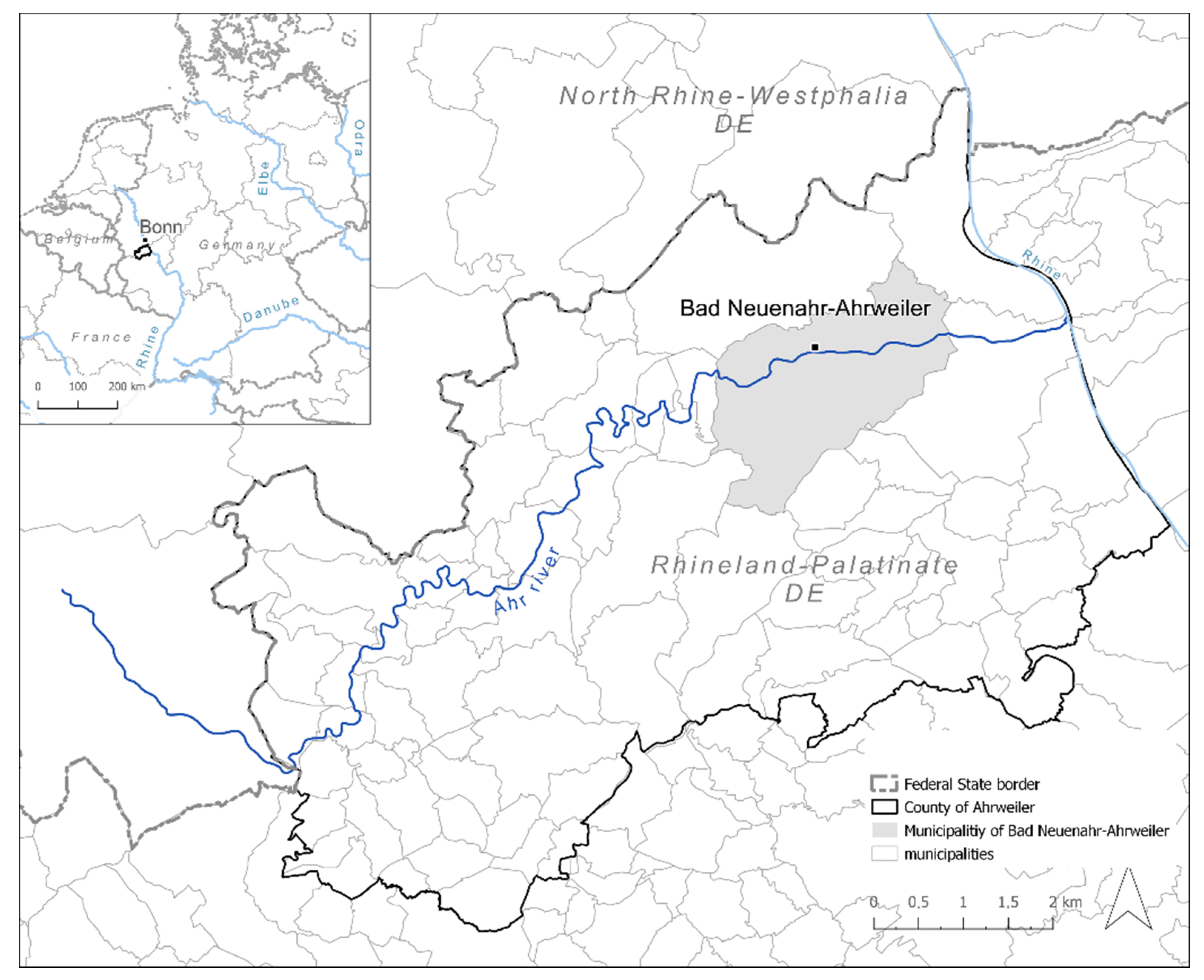
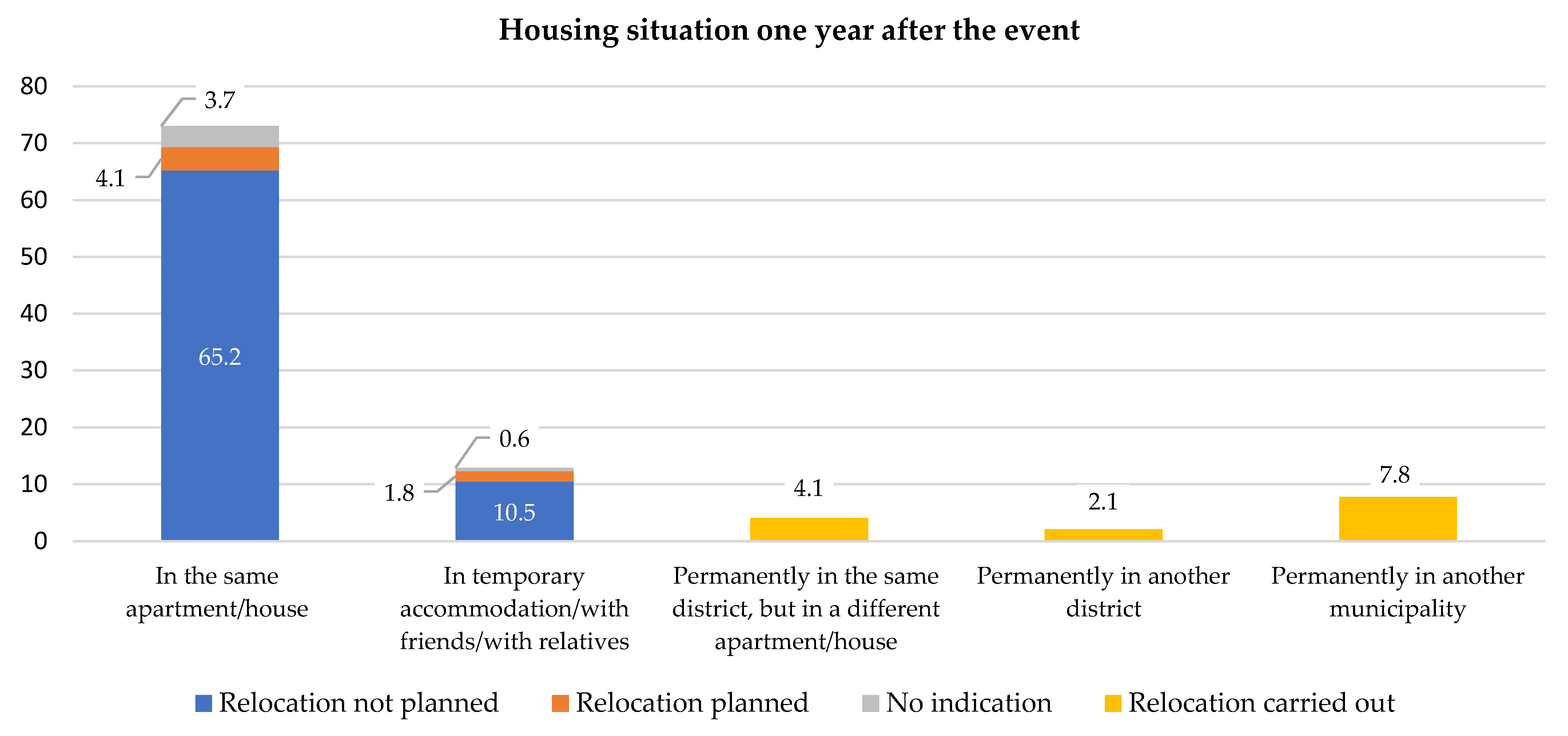
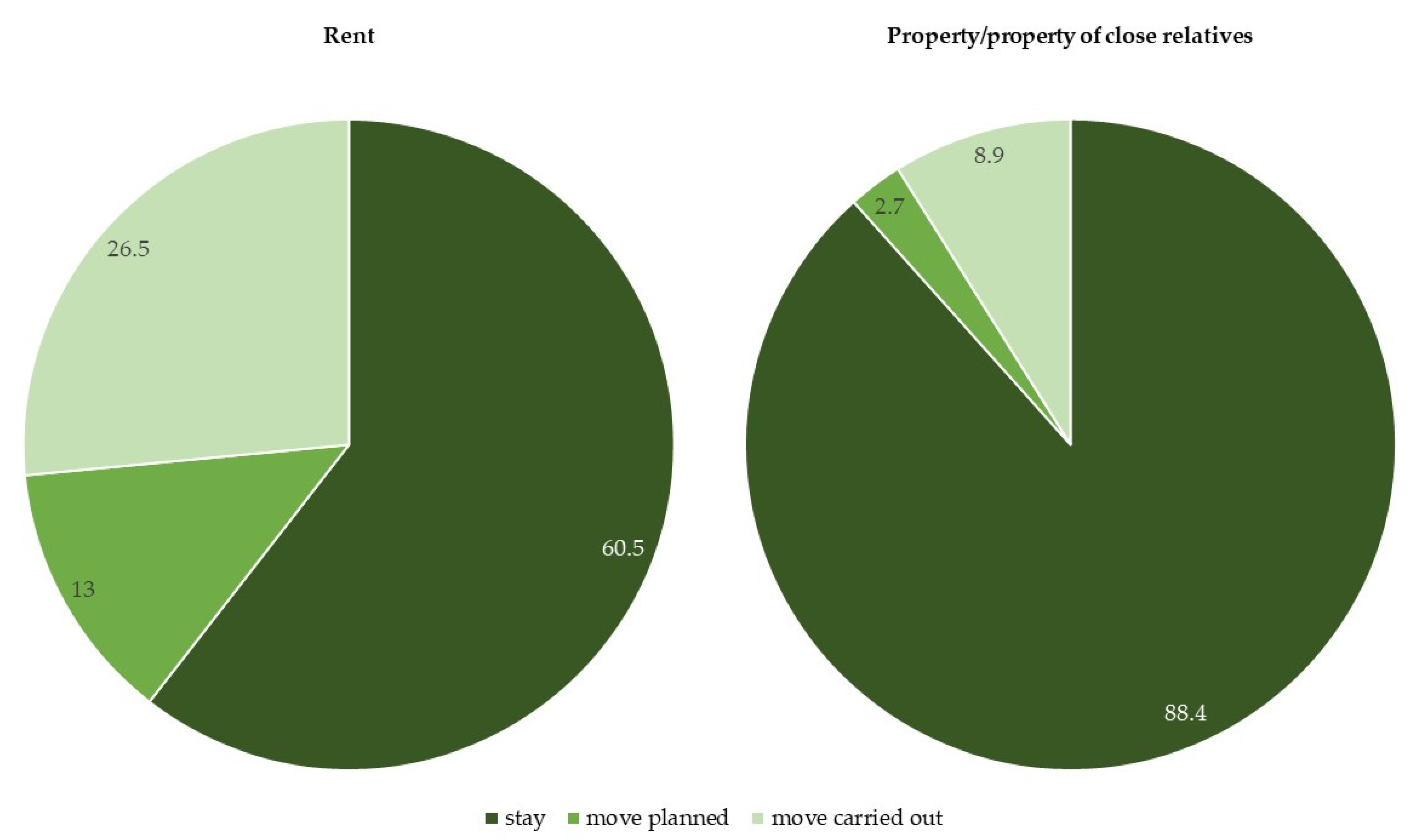
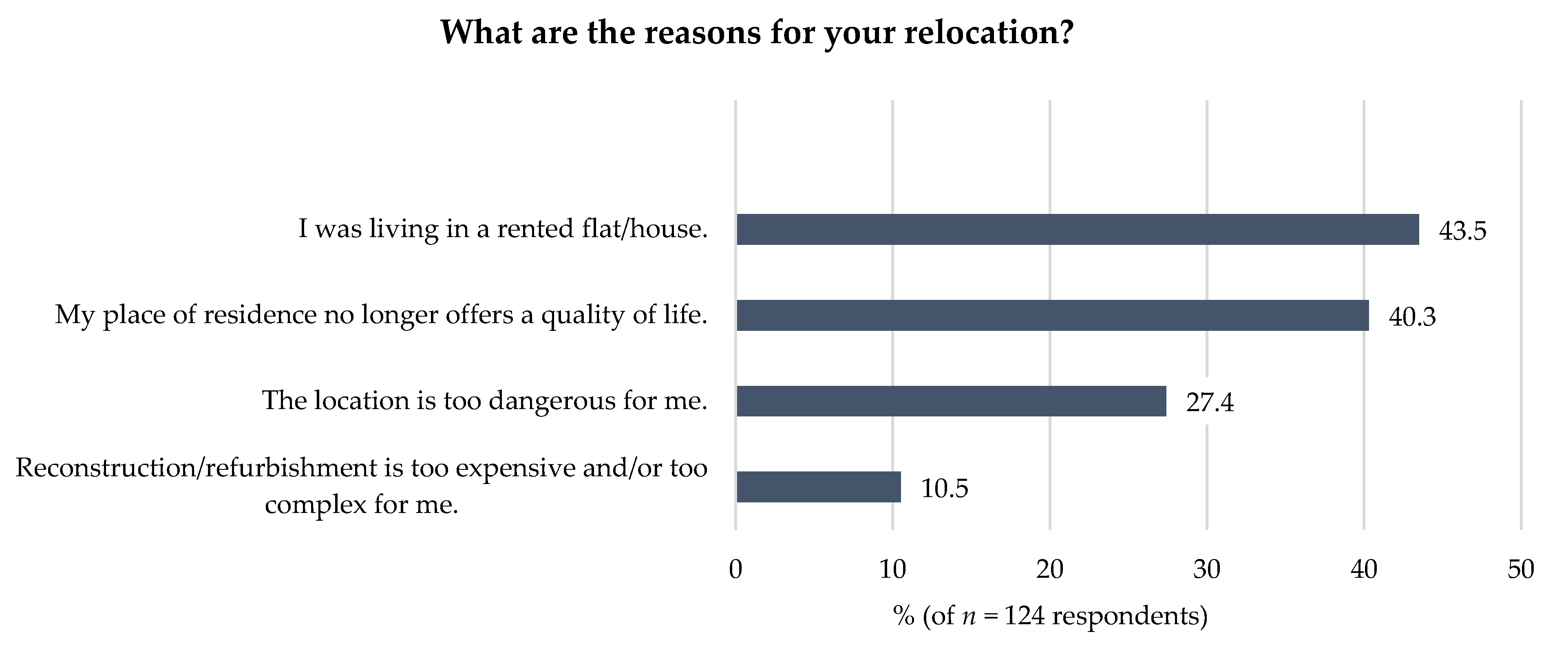
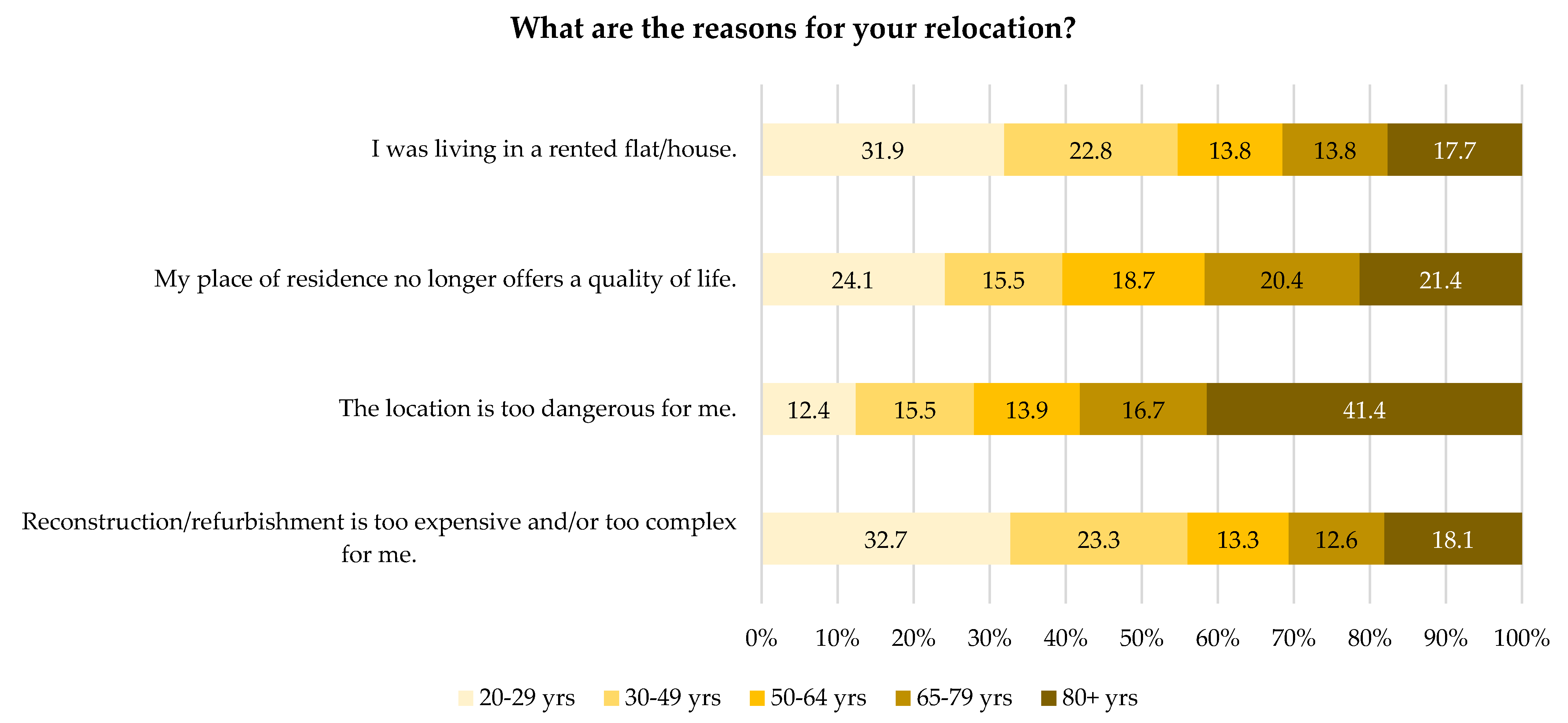
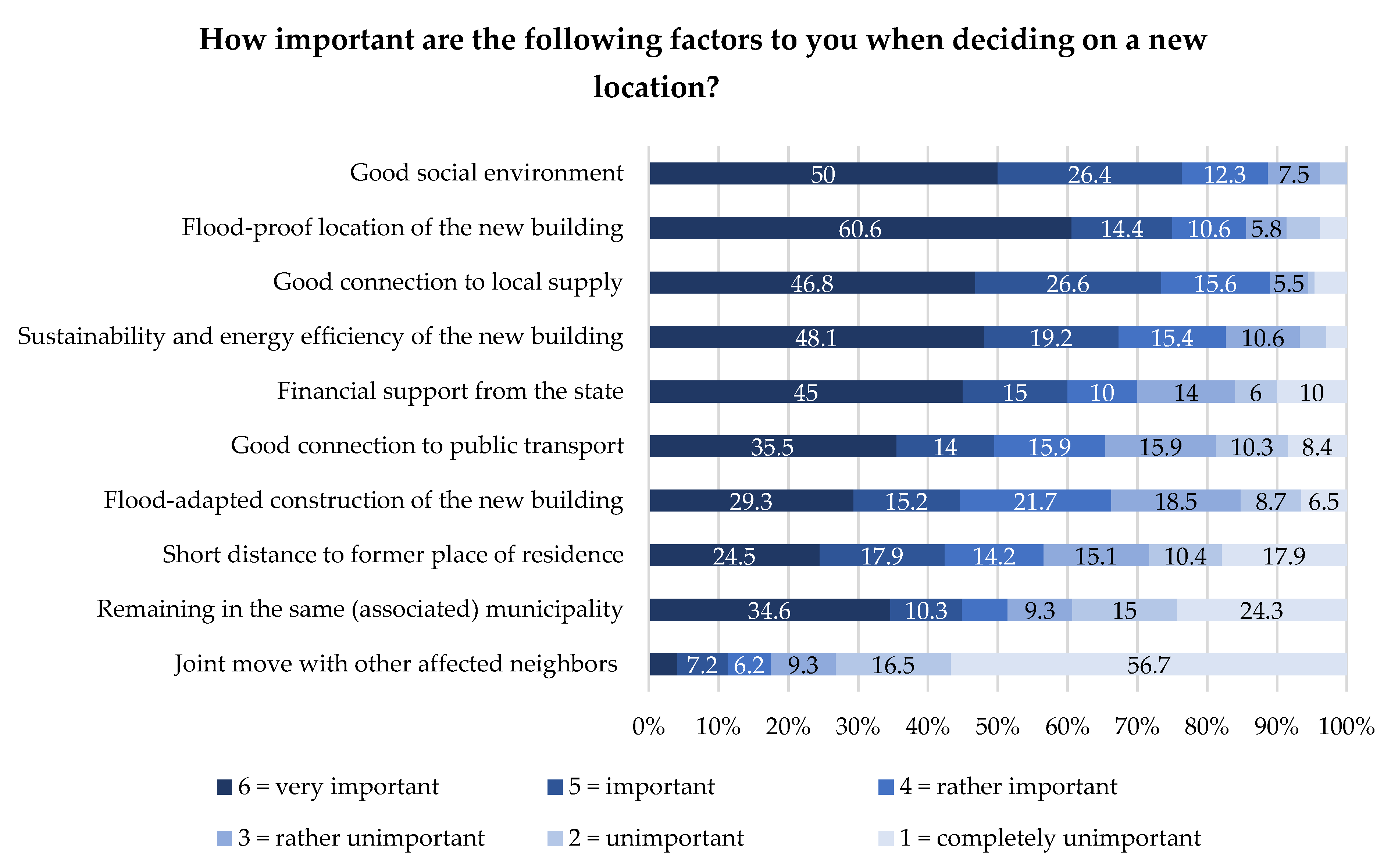
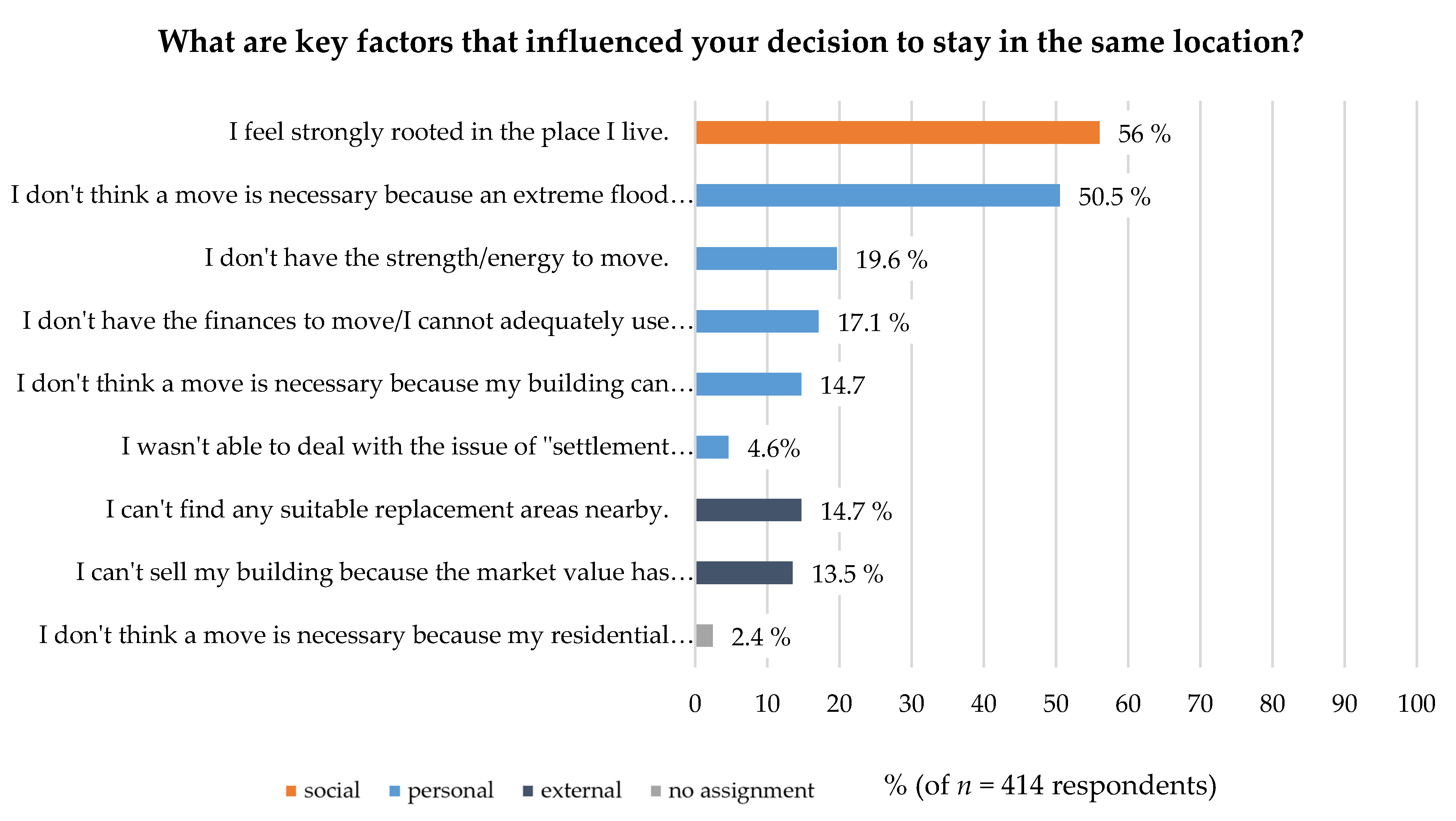
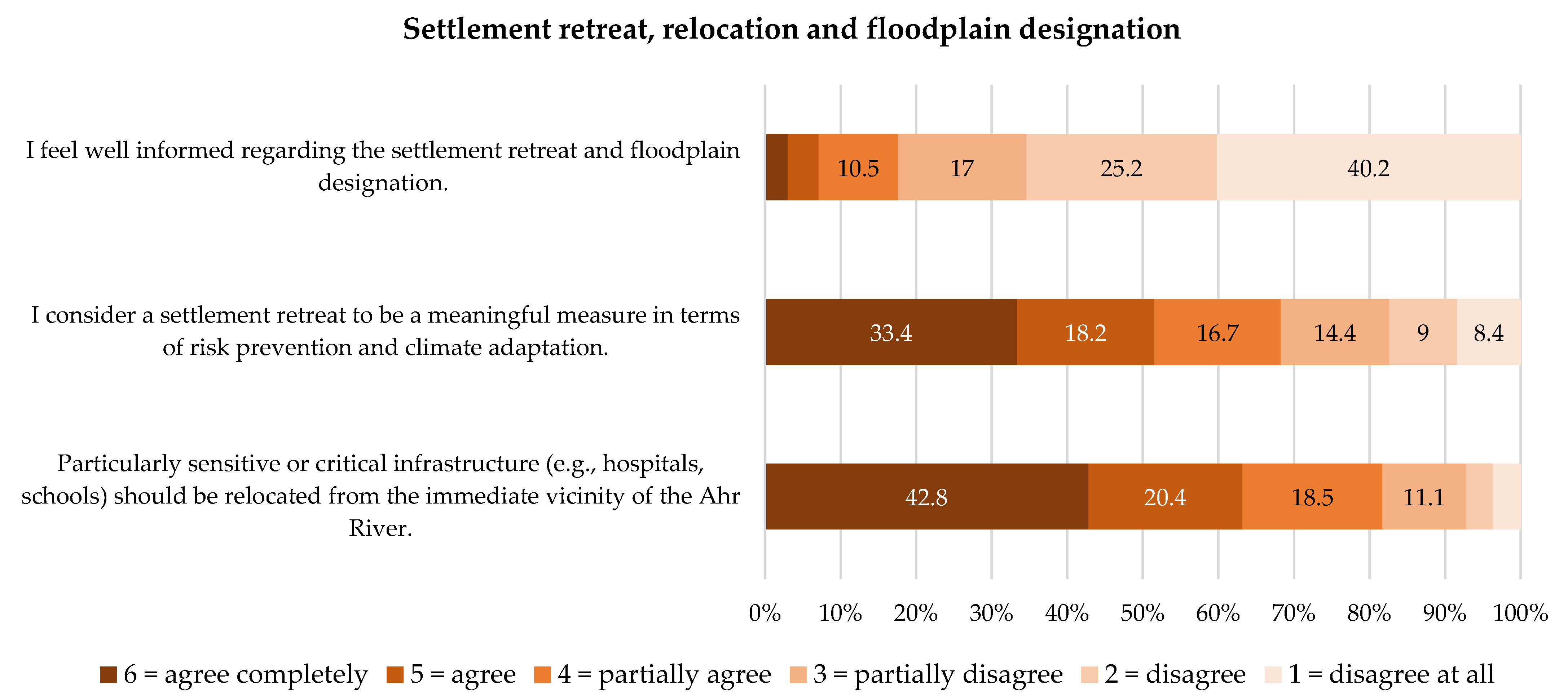
| Sample | Official Statistics | |
|---|---|---|
| Age (0–19/20–64/65+ years) [%] | -/67.0/33.0 | 17.6/57.4/25.0 (-/69.7/30.3) * |
| Gender (male/female/diverse) [%] | 52.4/47.6/- | 49.4/50.6/- |
| Income | 2600–3599 € per household (median) | 2030 € per resident |
| Homeowners [%] | 67.6 ** | 52.5 *** |
| After the 2021 Flood→ Before the 2021 Flood↓ | Inside the Legally Designated Floodplain Valid in July 2021 | Outside the Legally Designated Floodplain Valid in July 2021, but within the July 2021 Flood Zone | Outside the Legally Designated Floodplain and Outside the July 2021 Flood Zone |
|---|---|---|---|
| Inside the legally designated floodplain valid in July 2021 | 4 | 3 | 7 |
| Outside the legally designated floodplain valid in July 2021, but within the July 2021 flood zone | 2 | 8 | 20 |
| Outside the legally designated floodplain and outside the July 2021 flood zone | 0 | 0 | 1 |
| Age | Gender | Household Income | |||||||
|---|---|---|---|---|---|---|---|---|---|
| n | ρ | p | n | ρ | p | n | ρ | p | |
| Good social environment | 105 | −0.052 | 0.595 | 104 | −0.187 | 0.058 | 90 | 0.064 | 0.550 |
| Flood-proof location | 103 | 0.109 | 0.274 | 102 | −0.129 | 0.195 | 88 | 0.026 | 0.813 |
| Good connection to local supply | 108 | 0.033 | 0.738 | 107 | −0.087 | 0.371 | 93 | 0.180 | 0.085 |
| Sustainability and energy efficiency of the new building | 103 | 0.232 | 0.019 | 102 | −0.084 | 0.401 | 88 | −0.052 | 0.627 |
| Financial support from the state | 99 | −0.065 | 0.521 | 99 | −0.008 | 0.936 | 87 | −0.247 | 0.021 |
| Good connection to public transport | 106 | 0.163 | 0.095 | 105 | −0.014 | 0.887 | 91 | 0.163 | 0.095 |
| Flood-adapted construction of the new building | 91 | 0.121 | 0.251 | 90 | −0.235 | 0.026 | 91 | 0.189 | 0.073 |
| Short distance to the former place of residence | 105 | −0.104 | 0.292 | 104 | −0.200 | 0.042 | 91 | 0.050 | 0.641 |
| Remaining in the same (associated) municipality | 106 | 0.022 | 0.819 | 105 | −0.216 | 0.027 | 92 | −0.016 | 0.881 |
| Joint move with neighbours | 96 | 0.012 | 0.906 | 95 | −0.027 | 0.793 | 81 | −0.101 | 0.368 |
Disclaimer/Publisher’s Note: The statements, opinions and data contained in all publications are solely those of the individual author(s) and contributor(s) and not of MDPI and/or the editor(s). MDPI and/or the editor(s) disclaim responsibility for any injury to people or property resulting from any ideas, methods, instructions or products referred to in the content. |
© 2023 by the authors. Licensee MDPI, Basel, Switzerland. This article is an open access article distributed under the terms and conditions of the Creative Commons Attribution (CC BY) license (https://creativecommons.org/licenses/by/4.0/).
Share and Cite
Truedinger, A.J.; Jamshed, A.; Sauter, H.; Birkmann, J. Adaptation after Extreme Flooding Events: Moving or Staying? The Case of the Ahr Valley in Germany. Sustainability 2023, 15, 1407. https://doi.org/10.3390/su15021407
Truedinger AJ, Jamshed A, Sauter H, Birkmann J. Adaptation after Extreme Flooding Events: Moving or Staying? The Case of the Ahr Valley in Germany. Sustainability. 2023; 15(2):1407. https://doi.org/10.3390/su15021407
Chicago/Turabian StyleTruedinger, Alessa Jasmin, Ali Jamshed, Holger Sauter, and Joern Birkmann. 2023. "Adaptation after Extreme Flooding Events: Moving or Staying? The Case of the Ahr Valley in Germany" Sustainability 15, no. 2: 1407. https://doi.org/10.3390/su15021407
APA StyleTruedinger, A. J., Jamshed, A., Sauter, H., & Birkmann, J. (2023). Adaptation after Extreme Flooding Events: Moving or Staying? The Case of the Ahr Valley in Germany. Sustainability, 15(2), 1407. https://doi.org/10.3390/su15021407







